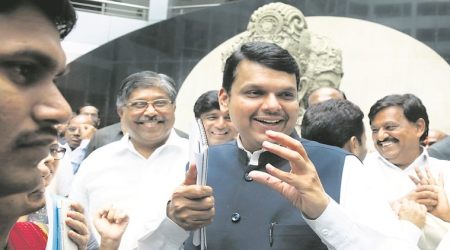 Wardha: Maharashtra Chief Minister Devendra Fadnavis with MP Ramdas Tadas during ‘Jalyukta Shivar Abhiyan’ function at Wardha in Maharashtra on Friday. (PTI Photo)
Wardha: Maharashtra Chief Minister Devendra Fadnavis with MP Ramdas Tadas during ‘Jalyukta Shivar Abhiyan’ function at Wardha in Maharashtra on Friday. (PTI Photo)
On January 26, 2015, when chief minister Devendra Fadnavis launched Jalyukta Shivar Abhiyan (JSA), around 25,000 out of Maharashtra’s 40,913 villages were identified as being particularly drought-prone. It is another matter that the back-to-back monsoon failures of 2014 and 2015 spared no part of the state.
Now exactly two-and half years on, with 388,572 works completed under this flagship programme at a total cost of Rs 5,481 crore, his government claims to have drought-proofed 11,484 of these villages mainly in the rainfed tracts of Vidarbha and Marathwada. In the next two-and-a-half years, starting from the post-monsoon period after mid-August, the target is to complete works on another 13,517 villages. That will make all of the 25,000 most-vulnerable villages in Maharashtra “drought-free”, in the sense of being able to cope up with at least one season of monsoon failure.
In a recent internal report, the state government’s department of water conservation noted that the works under JSA have so far created 15.73 lakh TCM (thousand cubic meters) of additional storage potential. The rainwater harvested through this extra storage capacity can provide protective irrigation to one crop on 20.61 lakh hectares and for two crops on 11.70 lakh hectares.
“Previous governments emphasised creating water storage through big dams and reservoirs, which were more expenditure-oriented. JSA has focused on build smaller water conservation structures, but which provide irrigation cover to more area for every rupee spent,” says Popatrao Pawar, sarpanch (chief) of Hiware Bazar, a village in Ahmednagar district seen as a role model for water and soil conservation.
The works under JSA have mainly involved widening and deepening of rivers; de-silting of lakes, ponds and canals; and construction of continuous contour trenches, check and earthen dams, compartment bunds and recharge shafts for harvesting rain water. This has been supplemented by a separate scheme — Magel Tyala Shet Tale Yojana — announced in February 2016 granting a Rs 50,000 subsidy for small and marginal farmers to build farm ponds. It received around 3.5 lakh applications, much more than the one lakh target that had been set for 2016-17.
“We need to now think ahead. When villages overcome water scarcity – more so in good monsoon years such as 2016 and the current year — it is natural for farmers to grow more water-intensive crops such as sugarcane, pomegranate and banana. The focus should now be equally on village-level water management and crop-planning,” cautions Pawar.
For chief minister Fadnavis, the notable feature of JVA has not just been creation of additional irrigation potential — whose effectiveness will, of course, be tested only in the next drought year — but people’s voluntary participation. Out of the total Rs 5,481 crore spent on the scheme, Rs 514 crore has been through public contributions towards construction of some 8,104 works. “They have not only generously donated money, but also lent physical support in the form shramdaan (voluntary labour contribution). The spirit of ownership is what has helped us take up this project on such a massive scale,” he tells The Indian Express.
Significantly, the criticism of JSA even across the political spectrum has been more over the manner of implementation than the scheme per se. “All powers of implementation and even choice of works are vested in the district collectors. They hardly consult the MLA (legislator) or local body representatives,” alleges Radhakrishna Vikhe-Patil, senior Congress leader and former state agriculture minister. He believes that the works should be more scientifically planned and not left in the hands of private contractors, while also calling for greater convergence between JSA and employment generation programmes such as MGNREGA.
Nationalist Congress Party politician and former deputy chief minister Ajit Pawar makes a similar point: “The programme is totally being run by government officials. There should, moreover, be a monitoring mechanism for the quality of works. If the structures built are not durable, it would mean huge public money going down the drain”.
A top official in the department of water conservation, however, denies these charges. “Every work is subject to public scrutiny, with all budget details and timelines displayed on the site itself. The images of the works, too, are geo-tagged and uploaded on our portal, right from the beginning to the end. We have not received complaints on even one per cent of works. Further, the district collector conducts interactions with the gram panchayat members before taking up any work,” he asserts.
But for Popatrao Pawar, the major worry is over JVA promoting water-intensive crop cultivation. “We should not lose sight of the more fundamental issue of addressing soil erosion and checking underground water depletion,” he warns.

